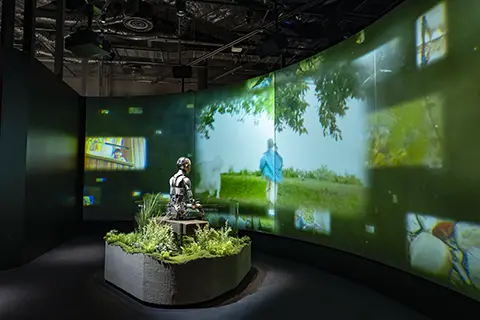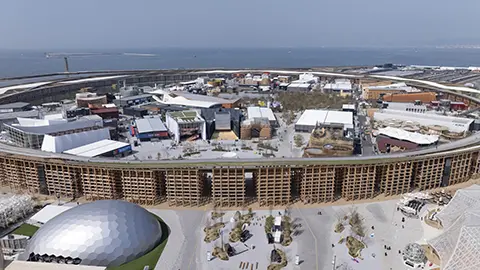
The symbol of Expo 2025 Osaka, Kansai, Japan — the “Grand Ring”
©Expo 2025
A World Expo is an event that brings together people and innovations from around the world in an effort to address issues facing humankind on a global scale.
Since its opening in April 2025, Expo 2025 Osaka, Kansai, Japan has attracted large crowds from both Japan and abroad, creating a vibrant and dynamic atmosphere each day. We spoke with ISHIGE Hiroyuki, Secretary General of the Japan Association for the 2025 World Exposition, about the Expo’s concept, significance, and key highlights.

ISHIGE Hiroyuki
Secretary General, Japan Association for the 2025 World Exposition
ISHIGE joined the Ministry of International Trade and Industry (now the Ministry of Economy, Trade and Industry) in 1974. He has held several key positions, including Director-General of the Small and Medium Enterprise Agency and Vice Minister for International Affairs. He served as Chairman and CEO of the Japan External Trade Organization (JETRO) until 2019 and assumed his current position that same year.
Could you share the concept behind Expo 2025 Osaka, Kansai, Japan and why it is especially meaningful to hold it now?
The theme of Expo 2025 Osaka, Kansai, Japan is “Designing Future Society for Our Lives,” making it the first-ever World Expo centered on the theme of life. Bringing together 158 countries and regions alongside 7 international organizations on Yumeshima Island in Osaka, the Expo provides a rare and valuable platform for global dialogue, exchange, and reflection on the future of society.
In these uncertain times, there is great significance in the world coming together in one place for 6 months to engage in direct, face-to-face conversations and collaboration, as we collectively explore a future without clear answers. This, I believe, embodies the true purpose of the Expo.
The divisions that deepened during the COVID-19 pandemic have been further intensified by recent conflicts such as Russia’s aggression against Ukraine and the situation surrounding the Gaza Strip. Against this backdrop, Expo 2025’s focus on life and its mission to reconnect a divided world are more important than ever before.
Thanks to the strong commitment and understanding of the Official Participants and other stakeholders, along with their dedicated efforts in organizing exhibitions, the Expo has welcomed a total of more than 9 million visitors as of June 22. We are sincerely grateful to the many people who continue to visit the Expo site each day.

Commemorating 5 million visitors: Secretary General ISHIGE with the official mascot MYAKU-MYAKU. The Expo has welcomed a total of more than 9 million visitors as of June 22.
©Expo 2025
What are the main highlights and the best ways for foreign visitors to enjoy the many pavilions and events from Japan and abroad?
The Expo site offers a diverse range of pavilions from Japan and around the world as well as numerous events. It’s truly rewarding to see so many people visiting the Expo and engaging with whatever attractions personally appeal to them the most. Here are 5 key highlights to explore:
First is the Expo’s centerpiece and symbol, the world’s largest wooden structure — the “Grand Ring.” Much like the Eiffel Tower at the 1889 Paris Expo and the Tower of the Sun at the 1970 Osaka Expo, this massive structure leaves a lasting impression on every visitor. Stretching approximately 2 km in circumference, visitors are awestruck by its immense scale and stunning panoramic views. Visitor surveys show that many describe the Grand Ring as a truly unforgettable highlight of their visit. Within the Grand Ring are pavilions representing countries and regions from across the world, allowing visitors to look out over a symbolic “globe” of the world and deeply connect with the Expo’s theme of “Unity in Diversity.”
Second are the international pavilions, often referred to as the “highlights of the Expo.” With 158 countries and regions participating—the largest number in the history of Japanese Expos—Expo 2025 is the only place where visitors can embark on a passport-free world tour. Many enjoy collecting stamps as souvenirs through a stamp rally, visiting pavilion after pavilion. Centered on the theme of life, these pavilions offer unique insights into how people around the world, including Japan, live and find happiness, providing a different kind of experience from that of ordinary travel.
Third are the Signature Pavilions that directly engage with the Expo’s core theme of life. Eight prominent theme producers from diverse fields have produced eight unique pavilions, each presenting a different perspective on life. These pavilions invite visitors to reflect deeply on this theme. For instance, Professor ISHIGURO Hiroshi’s pavilion showcases around 20 androids and nearly 30 robots, depicting a future where humans and androids coexist 50 years from now—a fascinating glimpse into a yet-to-be-seen world.

An example of a signature pavilion by producer ISHIGURO Hiroshi. Visitors can experience what life and products will be like 50 years from now, when humans coexist with androids.
©FUTURE OF LIFE / EXPO2025
Additionally, the Japan Pavilion, along with numerous pavilions from Japanese local governments, private companies, and organizations, offers immersive experiences focused on life and the future. The Japan Pavilion’s theme, “Between Lives”, is showcased in a striking circular structure constructed from 560 domestically sourced cedar cross-laminated timber (CLT) panels, each measuring up to 12 meters in length. From a sustainability standpoint, these panels will be reused after the Expo concludes.
The Osaka Healthcare Pavilion, presented by Osaka Prefecture and Osaka City, features the theme “REBORN”, allowing visitors to experience their future selves 25 years from now through avatars. Additionally, 13 pavilions by private corporations and organizations explore diverse perspectives on life. For example, the Pasona Natureverse Pavilion showcases cutting-edge iPS heart technology, captivating visitors with its lifelike display of a beating iPS heart.

Japan Pavilion using CLT panels made from domestically produced cedar wood.
©Expo 2025
Fourth are the daily live events held across the Expo site. Official Participants celebrate National Days and Special Days almost every day, featuring traditional dances from various countries and regions, performances by leading artists, and other shows that create a vibrant and energetic atmosphere. These events, visible throughout the site, infuse the Expo with a unique festive spirit that enchants many visitors.
Finally, the fifth highlight is the unique opportunity to experience and learn about Japan itself through the Expo. For foreign visitors, the Expo offers a rare chance to explore Japan comprehensively in a short period. Throughout the Expo period, festivals from all over Japan are showcased, and in August, a Grand Sumo Tournament will take place on site. Beyond traditional culture, there are also events that blend anime and cuisine, so we encourage visitors to check the official website for schedules and join in the festivities.
Moreover, the Expo offers a rich variety of global cuisines alongside authentic Japanese dishes. Visitors can enjoy everything from sushi and ramen to sweets and local Kansai specialties available at pavilions and food courts. For international guests seeking a comprehensive experience of Japan—from culture to cuisine—the Expo is an exceptionally appealing destination.

Osaka Health Care Pavilion exhibited by Osaka Prefecture and Osaka City
©Expo 2025
Expo 2025 is the first World Expo held in Osaka in 55 years since 1970, with local governments from Osaka and the Kansai region also participating. Could you please share the significance of hosting the Expo here?
One key point of significance is that the Expo presents a major opportunity to strengthen the Osaka-Kansai global profile. Successfully hosting the Expo during these challenging times will undoubtedly garner widespread international recognition and create a lasting legacy for the region.
Secondly, through the Expo, the Osaka-Kansai area positions itself to serve as gateway between Japan and the world. Last year, inbound visitors to Osaka reached a record high of 14.64 million, and this figure is expected to rise further this year. Additionally, the region’s potential as a gateway for global business is promising. Many countries, including Italy, China, Malaysia, and the Nordic countries, have dispatched business delegations to Japan in conjunction with the Expo. With its vast population and economic zone, the Osaka-Kansai area can leverage the Expo as a catalyst for sustained medium- to long-term growth, making a significant contribution to regional revitalization across Japan as a whole.
Expo 2025 brings together initiatives from around the world under the theme ‘Designing Future Society for Our Lives’, serving as a platform to advance the Sustainable Development Goals (SDGs) and envision the future beyond them. Could you introduce some of the specific initiatives featured at the Expo?
The Expo site gathers global wisdom on the SDGs. For example, one of the notable features of this Expo is that many pavilions have used natural materials such as wood, bamboo, and straw in their construction. Numerous buildings have been designed to be reused and recycled after the Expo concludes. Additionally, many pavilions have focused their exhibits specifically on SDGs-related themes.
Following the Dubai Expo, the Theme Weeks continue to be a highlight. These weekly programs address universal human themes such as “Health and Well-being Week” and “Necessities of Life: Food, Clothing, and Shelter Week”, featuring speakers from numerous countries and regions. They also provide valuable opportunities for business exchange.
True to the Expo’s concept of being a “People’s Living Lab”, visitors can experience many cutting-edge technologies on site. For instance, the Expo site hosts a carbon recycling factory that produces e-methane from captured CO₂, which is then used for cooking and heating throughout the site. This allows visitors to witness the current state of carbon recycling up close. The Expo site itself aims to offer visitors a tangible experience of a future society in action.
Secretary-General ISHIGE concluded by emphasizing the significance of the Expo for future generations.
Another important aspect is that the Expo will remain in people’s memories. It offers children and young people—those who will lead the future—an invaluable opportunity to encounter diverse cultures, broaden their perspectives, and explore their own potential. Just as many people still speak fondly of their experiences at Expo ’70, even after half a century, this Expo aims to leave a similarly lasting impression.
In the 80 years since World War II, only 10 large-scale World Expos have taken place worldwide, and Osaka is the first city in the world to host a second Expo after a 55-year gap. As it is such a rare and valuable opportunity, I hope that many people including those from abroad will visit the Expo.

A scene from Turkmenistan’s National Day event.
©Expo 2025

MYAKU-MYAKU, the official mascot of Expo 2025 Osaka, Kansai, Japan (See: See: Say Hello to the Expo Mascots – A Simple Guide in English)
©Expo 2025
By TANAKA Nozomi
Photo: ©Expo 2025; ©FUTURE OF LIFE / EXPO2025
PREVIOUS
Expo 2025 Osaka, Kansai, Japan

NEXT
Food Culture Experience Programs Unique to Osaka

Feedback and Comments
Thank you for your feedback
Your valuable feedback and commnents will be referenced for our future operations.
Close


AloJapan.com